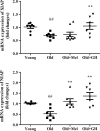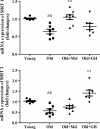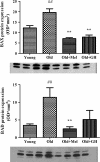Growth hormone and melatonin prevent age-related alteration in apoptosis processes in the dentate gyrus of male rats
- PMID: 23852044
- PMCID: PMC3739870
- DOI: 10.1007/s10522-013-9443-6
Growth hormone and melatonin prevent age-related alteration in apoptosis processes in the dentate gyrus of male rats
Abstract
It has been suggested that the age-related decrease in the number of neurons in the hippocampus that leads to alterations in brain function, may be associated with an increase in apoptosis due to the reduced secretion of growth hormone (GH) and/or melatonin in old animals. In order to investigate this possibility, male Wistar rats of 22 months of age were divided into three groups. One group remained untreated and acted as the control group. The second was treated with growth hormone (hGH) for 10 weeks (2 mg/kg/d sc) and the third was subjected to melatonin treatment (1 mg/kg/d) in the drinking water for the same time. A group of 2-months-old male rats was used as young controls. All rats were killed by decapitation at more than 24 month of age and dentate gyri of the hippocampi were collected. Aging in the dentate gyrus was associated with an increase in apoptosis promoting markers (Bax, Bad and AIF) and with the reduction of some anti-apoptotic ones (XIAP, NIAP, Mcl-1). Expressions of sirtuin 1 and 2 (SIRT1 and 2) as well as levels of HSP 70 were decreased in the dentate gyrus of old rats. GH treatment was able to reduce the pro/anti-apoptotic ratio to levels observed in young animals and also to increase SIRT2. Melatonin reduced also expression of pro-apoptotic genes and proteins (Bax, Bad and AIF), and increased levels of myeloid cell leukemia-1 proteins and SIRT1. Both treatments were able to reduce apoptosis and to enhance survival markers in this part of the hippocampus.
Figures










Similar articles
-
Melatonin and oestrogen treatments were able to improve neuroinflammation and apoptotic processes in dentate gyrus of old ovariectomized female rats.Age (Dordr). 2014;36(5):9707. doi: 10.1007/s11357-014-9707-3. Epub 2014 Aug 19. Age (Dordr). 2014. PMID: 25135305 Free PMC article.
-
Molecular mechanisms involved in the hormonal prevention of aging in the rat.J Steroid Biochem Mol Biol. 2008 Feb;108(3-5):318-26. doi: 10.1016/j.jsbmb.2007.09.010. Epub 2007 Sep 7. J Steroid Biochem Mol Biol. 2008. PMID: 18252241
-
Effect of exogenous administration of melatonin and growth hormone on pro-antioxidant functions of the liver in aging male rats.J Pineal Res. 2007 Jan;42(1):64-70. doi: 10.1111/j.1600-079X.2006.00385.x. J Pineal Res. 2007. PMID: 17198540
-
Effect of chronic melatonin administration on several physiological parameters from old Wistar rats and SAMP8 mice.Curr Aging Sci. 2012 Dec;5(3):242-53. doi: 10.2174/1874609811205030012. Curr Aging Sci. 2012. PMID: 23387890 Review.
-
Protective actions of melatonin and growth hormone on the aged cardiovascular system.Horm Mol Biol Clin Investig. 2014 May;18(2):79-88. doi: 10.1515/hmbci-2014-0016. Horm Mol Biol Clin Investig. 2014. PMID: 25390004 Review.
Cited by
-
Sirtuin-2 inhibition affects hippocampal functions and sodium butyrate ameliorates the reduction in novel object memory, cell proliferation, and neuroblast differentiation.Lab Anim Res. 2016 Dec;32(4):224-230. doi: 10.5625/lar.2016.32.4.224. Epub 2016 Dec 23. Lab Anim Res. 2016. PMID: 28053616 Free PMC article.
-
Understanding the Potential Role of Sirtuin 2 on Aging: Consequences of SIRT2.3 Overexpression in Senescence.Int J Mol Sci. 2021 Mar 18;22(6):3107. doi: 10.3390/ijms22063107. Int J Mol Sci. 2021. PMID: 33803627 Free PMC article.
-
Melatonin regulates the aging mouse hippocampal homeostasis via the sirtuin1-FOXO1 pathway.EXCLI J. 2017 Mar 23;16:340-353. doi: 10.17179/excli2016-852. eCollection 2017. EXCLI J. 2017. PMID: 28507478 Free PMC article.
-
Effects of GH on the Aging Process in Several Organs: Mechanisms of Action.Int J Mol Sci. 2022 Jul 16;23(14):7848. doi: 10.3390/ijms23147848. Int J Mol Sci. 2022. PMID: 35887196 Free PMC article. Review.
-
Aging, longevity, and the role of environmental stressors: a focus on wildfire smoke and air quality.Front Toxicol. 2023 Oct 11;5:1267667. doi: 10.3389/ftox.2023.1267667. eCollection 2023. Front Toxicol. 2023. PMID: 37900096 Free PMC article. Review.
References
-
- Alvira D, Tajes M, Verdaguer E, Acuna-Castroviejo D, Folch J, Camins A, Pallas M. Inhibition of the cdk5/p25 fragment formation may explain the antiapoptotic effects of melatonin in an experimental model of Parkinson’s disease. J Pineal Res. 2006;40:251–258. doi: 10.1111/j.1600-079X.2005.00308.x. - DOI - PubMed
-
- Andrabi SA, Sayeed I, Siemen D, Wolf G, Horn TF. Direct inhibition of the mitochondrial permeability transition pore: a possible mechanism responsible for anti-apoptotic effects of melatonin. FASEB J. 2004;18:869–871. - PubMed
-
- Arbour N, Vanderluit JL, Le Grand JN, Jahani-Asl A, Ruzhynsky VA, Cheung ECC, Kelly MA, MacKenzie AE, Park DS, Opferman JT, Slack RS. Mcl-1 is a key regulator of apoptosis during CNS development and following DNA damage. J Neurosci. 2008;28(24):6068–6078. doi: 10.1523/JNEUROSCI.4940-07.2008. - DOI - PMC - PubMed
Publication types
MeSH terms
Substances
LinkOut - more resources
Full Text Sources
Other Literature Sources
Medical
Research Materials

